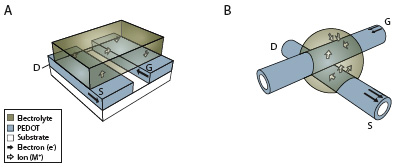| Posted: Apr 04, 2007 | |
Woven logic from organic electronic fibers |
|
| (Nanowerk Spotlight) In the future, wearable electronics will go far beyond just very small electronic devices. Not only will such devices be embedded on textile substrates, but an electronics device or system could become the fabric itself. Electronics textiles will allow the design and production of a new generation of garments with distributed sensors and electronic functions. Such e-textiles will have the revolutionary ability to sense, act, store, emit, and move (think biomedical monitoring functions or new man-machine interfaces) while leveraging an existing low-cost textile manufacturing infrastructure. Reporting a novel approach through the construction of all-organic wire electrochemical transistor devices (WECT) , researchers in Sweden show that textile monofilaments can be coated with continuous thin films of a conducting polymer and used to create microscale WECTs on single fibers. They also demonstrate inverters and multiplexers for digital logic. This opens an avenue for three-dimensional polymer micro-electronics, where large-scale circuits can be designed and integrated directly into the three-dimensional structure of woven fibers. | |
| This report is not the first one that shows that textile fibers have been endowed with electronic functions, but only a very limited number of papers have been published in this field during the last couple of years where single transistors have been demonstrated on single fibers. | |
| "This is the first time that an all organic transistor has been demonstrated on a single textile fiber, no metal is used, and it is also the first time that digital systems have been built directly on fibers" Mahiar Hamedi tells Nanowerk. "In contrast to previous work, which has focused on functionalizing fibers after the cloth is manufactured, another novelty of our work is that we use functional monofilaments when we make the electronic textile." | |
| Hamedi, a PhD student in the Bimolecular and Organic Electronics research group at the Department of Physics, Chemistry and Biology at Linköpings University in Sweden. is first author of a recent paper in Nature Materials that describes the realization of fabrics from electrically active monofilaments together with the construction of WECTs ("Towards woven logic from organic electronic fibers"). | |
| The operation of an electrochemical transistor (ECT) is on the basis of a reversible process of doping/de-doping of electronic polymers. One of the most promising materials so far for ECTs is the low-bandgap conducting polymer poly(3,4-ethylenedioxythiophene) (PEDOT), owing to its high conductivity and water dispersibility, for example in the form of PEDOT/PSS, and environmental stability. | |
| "The operation of PEDOT ECTs relies on switching the conductivity of a transistor channel consisting of PEDOT/PSS, through a reversible redox process in thin films of PEDOT that are in contact with a common electrolyte" says Hamedi. "Doping and de-doping of PEDOT can result in conductivity changes of up to five orders of magnitude." | |
| While ECTs have previously been demonstrated on flat surfaces, they can also be realized in non-planar geometries. By using cylindrical PEDOT films it is possible to construct ECTs on wires – WECTs. The realization of WECTs on textile fibers requires monofilaments of textile fibers that are coated with PEDOT films. | |
 |
|
| A) Schematic picture of a planar ECT (S, source; D, drain; G, gate). B) Schematic picture of a wire ECT (WECT). (Image: Mahiar Hamedi) | |
| "We have shown that textile can also be created by weaving coated monofilaments instead of coating the already woven textile" says Hamedi. The fiber coating can withstand mechanical stretch and scratch using standard textile processes such as weaving and knitting, allowing for the construction of electronic structures." | |
| Construction of fabric from coated monofilaments has many advantages, such as the possibility of fibers with continuous and uniform coatings and the possibility of different fibers in the same fabric. | |
| Hamedi points out that the WECTs not only possess interesting properties for electronic fabrics, but that they also have characteristics that are beneficial for large-scale electronic design on fabrics: | |
|
|
|
| The Swedish researchers have demonstrated that two transistors at a distance of twice the fiber diameter on a fiber can operate without any crosstalk. Their experiments indicate that it would be theoretically possible to construct 100,000 transistors/cm2. | |
| "Transistor packing densities would increase by taking advantage of the third dimension" says Hamedi. "The architectural design of any general fabric electronic circuit, for example digital circuits, is now just a question of design, where the combination of three-dimensional fabric design followed by textile patterning can be used to construct a complete device." | |
 By
Michael
Berger
– Michael is author of three books by the Royal Society of Chemistry:
Nano-Society: Pushing the Boundaries of Technology,
Nanotechnology: The Future is Tiny, and
Nanoengineering: The Skills and Tools Making Technology Invisible
Copyright ©
Nanowerk LLC
By
Michael
Berger
– Michael is author of three books by the Royal Society of Chemistry:
Nano-Society: Pushing the Boundaries of Technology,
Nanotechnology: The Future is Tiny, and
Nanoengineering: The Skills and Tools Making Technology Invisible
Copyright ©
Nanowerk LLC
|
Become a Spotlight guest author! Join our large and growing group of guest contributors. Have you just published a scientific paper or have other exciting developments to share with the nanotechnology community? Here is how to publish on nanowerk.com.
